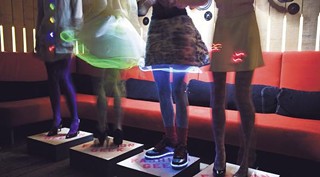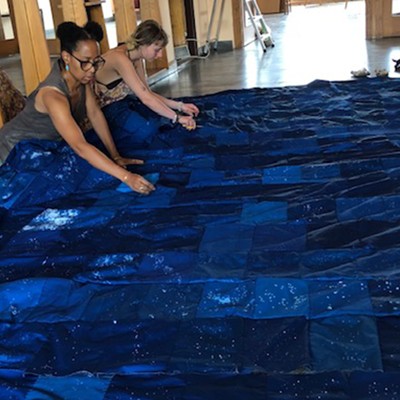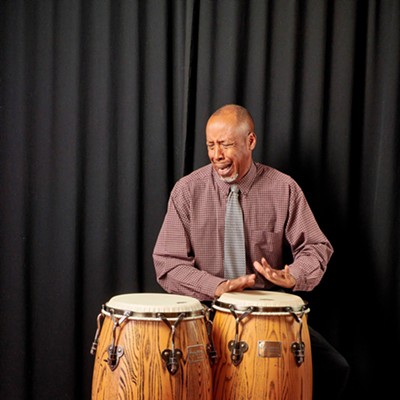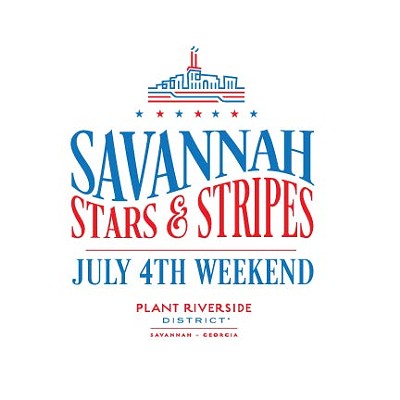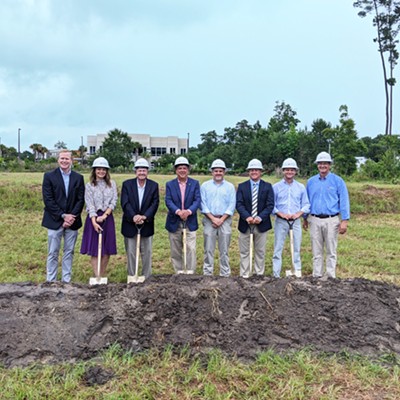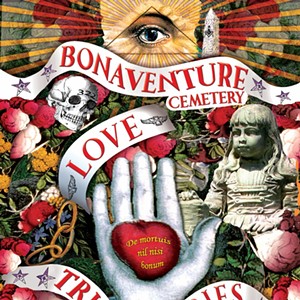For the last several years, Diana Eng has stood at the crossroads of fashion and technology, working on items seemingly pulled from science–fiction novels — a hoodie that knows when you’re excited, a purse that takes pictures of all the places you’ve been, and a stylish ensemble that changes shape at your command.
Although she might be most widely known for her appearance on Project Runway’s second season, the author of Fashion Geek will be in Savannah spreading the gospel of technology at the Telfair’s Pulse festival, where she’ll be running a workshop on how to sew with conductive thread (embroidery that lights up – seriously), and giving a lecture about how technology and fashion can work together.
We caught up with her last week to talk about the transition from hacking to fashion and how combining science and fairy tales will help kids be more interested in engineering.
What came first for you fashion or technology?
Diana Eng: I was interested in technology first. It was really more math and science. I really wanted to be a mathematician, since I was like two, but I didn’t like solving equations, it wasn’t fun. Fashion was fun because it turns out fashion uses a lot of mathematics. Now I get to do math everyday, but I don’t have to do equations and I get to go shopping all the time. That’s my job.
I read somewhere that you were also into computer hacking before you got into fashion. At what point did your interests start to change?
Diana Eng: I guess when I was in high school. I liked art a little bit, and I ended up going to a summer art program where I was going to do architecture – because you know architecture is kind of a good combination of science and math and art – but my art class got cancelled and I ended up taking a fashion class, which was even better.
You have to wait for a building to get built to see what it looks like – but with fashion you sew it, you turn it inside out, and you get to see the final product. Plus, it’s kind of more challenging because you’re making these 3–D shapes on the body, and they’re actually moving. I think that’s how I got into fashion and ever since I’ve been very interested in it.
Do you find that the fashion technology side of the industry exists in a different world from the haute couture and the designer stuff or does everybody play in the same sandbox?
Diana Eng: Fashion and technology has been in high end fashion. It’s a perfect candidate for couture because couture isn’t really wearable as an everyday clothing item, and a lot of the fashion technology things aren’t either.
It’s kind of a fun thing to see on the runway. I think some of the things are starting to get ready for use by commercial industry. I used to work at Victoria’s Secret in the research and development department, and they were doing a lot of interesting things there. They actually had a bra that had chemicals that would get absorbed through your skin. That’s very big in Japan. They have all these vitamin shirts and caffeine stockings.
That’s crazy. I didn’t think Japan could get any crazier, but it just did.
Diana Eng: They have deodorant shirts, which I think are kind of cool, because then you don’t have to put deodorant on, you just put on your deodorant shirt.
What is your workshop at the Pulse Festival going to cover?
Diana Eng: I’m going to look at sewing with conductive thread. It’s going to be basic for everyone who wants to get started with fashion and technology. Conductive thread is like normal thread, but you can use it instead of wires to make circuits. We’re going to be hand embroidering our own circuits and we’ll use some LEDs and batteries and make different circuit embroidery patterns that light up.
Is that where everyday clothing is headed? Will all our clothes light up and come with battery packs attached?
Diana Eng: It’s kind of an emerging thing. There are actually batteries that are paper–thin and flexible, so those are the type they’ll probably put in clothing one day. I don’t think they’d use conductive thread, because it’s actually kind of expensive, but you can screen print circuits on clothes, like the same way you screen print t–shirts, so I imagine they screen print a circuit on the clothing and use a paper–thin battery.
How did your stint on Project Runway affect your trajectory in the fashion world?
Diana Eng: I think it helped me to get some more opportunities. Lots of people have been doing the research and the high tech crafting, but I’m sort of a more mainstream person. It’s been an opportunity to talk about fashion and technology to the general population. It’s been fun, because I’m coming at it more from the fashion side, and there aren’t that many designers in the United States who come at from the fashion side instead of the academic or the crafting side.
How does that change your approach?
Diana Eng: There are people who think about it artistically – like how is this going to affect things socially. I’m more interested in creating a new style or a new visual effect – that’s what’s more interesting to me.
Do you ever wear any of your creations around?
Diana Eng: The thing I wore around a lot was the blogging purse. That was really fun because it took a photo every 20 steps and automatically uploaded it to a blog. Then you could trace back through your footsteps by looking at the photographs. It was cool because you know when you’re walking you might zone out and you might not know where you’re going.
Doesn’t that have the potential for some incredibly awkward photos?
Diana Eng: Yes, it got some awkward photos too. It had pretty good placement though because it was on the shoulder. It got a good perspective. It wasn’t just taking pictures of feet all the time.
Does that sort of border on the realm of too much information? Where is the line between realizing things your automated mind may be skipping over, like walking around, and overwhelming yourself with unnecessary information?
Diana Eng: I think some people might want to wear it everyday because it’s like people with Twitter who Twitter everything that happens to them and then they are always reading all their friends’ pages to see where they went to lunch. So and so just ate a sandwich – that’s too much information too, but I kind of feel like this would be appealing to that type of person.
What’s next for you?
Diana Eng: I’ve been working on a project called fairytale fashion. It’s an educational project. We’re using technology to make things that would only be possible in a fairytale. It’s magical clothing that transforms or changes shape or color or has blooming flowers. We have a series of web videos that talk about how the technology works and then the students can send in ideas for how the technology can be used in the fashion designs.
For example, we were thinking about transforming clothing, so we looked at deployable structures. An umbrella is a deployable structure – something that changes shape really easily. The kids were really fascinated by it. They don’t necessarily realize it’s a mechanical engineering thing. They might usually associate building bridges with mechanical engineering. I thought it was a neat way to show or introduce new ideas to different people and the general public.
Do you have the most fun job ever? Or are there other fun jobs you’re trying to work toward?
Diana Eng: This is pretty fun. Right now I’m at a place called iBeam. I have an art residency here. We’ve playing with the laser cutter and the 3–D printer and the programmable sewing machine. It’s been lots of fun.
Diana Eng’s workshop will take place at the Jepson Center on Wednesday, Jan. 27 at 4 p.m. Her lecture is Thursday, Jan.28 at 6 p.m. For more information on her Fairytale Fashion project visit www.fairytalefashion.org.

